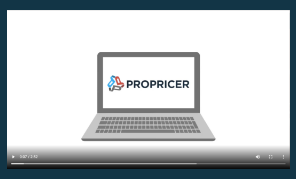As society becomes increasingly aware of the inequities embedded into everyday life and business, more efforts are being made to level the playing field. Set-asides and minority programs were once the gold standard in agency procurement. Now, we’re on the cusp of an even greater overhaul.
President Biden has set forth an ambitious initiative to improve inclusiveness, diversity, and equity across federal branches. (1) His new Executive Order 13985 has far-reaching implications on enhancing contracting opportunities for Small Disadvantaged Businesses (SDBs).
Here’s what the latest federal procurement policies mean for your business and your own contract pricing strategy.
Leveling the contract field
EO 13985, titled “Advancing Racial Equity and Support for Underserved Communities,” is a key initiative for promoting equity, inclusion, and a fairer distribution of resources.
It outlines a number of provisions for eliminating barriers that put certain groups at a disadvantage. It also prescribes proactive steps government agencies can take to ensure impartial treatment of all individuals.
The order will accomplish its goals by requiring federal agencies to:
- Review agency policies to determine whether they create or exacerbate barriers to full participation by historically disadvantaged groups.
- Review agency programs to assess whether contracts are equally available to all.
- Reevaluate strategies for allocating federal resources to address “the historic failure to invest sufficiently, justly, and equally in underserved communities.”
- Design a plan to address barriers that inhibit full participation in government programs.
- Collaborate with members of historically underrepresented communities as well as civil rights and community-based organizations to devise strategies for equitable opportunity access. (1)
$100 billion to SDBs
One of the Biden administration’s main objectives is to direct $100 billion in federal contracting opportunities to SDBs over the next five years.
At the moment, 10% of all federal contracts are awarded to SDBs. However, the Office of Management and Budget is aiming to expand this figure to 15% by 2025. (3)
Small businesses, especially SDBs, are positioned to benefit from these developments—as long as you take the initiative to capitalize on them.
Establishing an inter-agency workgroup
Inadequate data collection can often impede efforts to measure discrimination. At worst, this can result in policies that fail to address the needs of historically disadvantaged demographics.
Another facet of Biden’s plan aims to tackle this issue head on—with the development of an “Interagency Working Group on Equitable Data.”
This group will screen federal data collection programs to identify errors among key demographic variables, such as race, ethnicity, gender, disability, income, and more.
They will also provide recommendations to make federal data collection programs more coordinated and democratized. The end goal is to improve data collection so it can enhance efforts to improve equity.
What this means for you
The latest inclusion measures will hold varying implications for different types of businesses—possibly even causing shifts in each firm’s respective contract pricing strategy.
Minority-owned businesses will witness an increasing number of opportunities in the federal contracting space. The market is expanding for SDBs, which means that it’s a great time to ramp up proposals and seize new deals.
On the other hand, businesses and their owners who don’t belong to historically disadvantaged groups will need to start paying more attention to internal policies. Companies that work with federal agencies will notice an uptick in inquiries about Diversity, Equity, and Inclusion (DEI) policies and data. Soon, agencies may be less inclined to collaborate if you’re falling short on key DEI measures.
It helps to reevaluate, even redefine, your DEI policies and goals. Consider introducing diversity and anti-bias training, implementing mentorship programs, switching up recruitment measures, hiring diversity managers, and more.
If you’re unsure where to start, a great resource is Alexandra Kalev and Frank Dobbin’s book - Companies Need To Think Bigger than Diversity Training (1).
Remove structural barriers yourself
The changes that will come into play over the next few years will empower small businesses, and especially SDBs, to succeed. That said, you’ll still need to take matters into your own hands to capitalize on growing opportunities.
Here’s a snapshot of some practical contract pricing strategies to help your business secure new deals and reach new heights.
|
Key Moment |
Strategies |
|
Getting a contract |
Joining sub-contracting programs, implementing diversity measures, implementing bid discounts, grading primes, networking, and seeking out loan programs |
|
Getting paid |
Networking with agency staff, and using online subcontract systems |
|
Building bonding capacity |
Training, coaching, and requiring graduate degrees of your employees |
|
Securing a larger prime contract |
Researching set-asides for small businesses, using bid discounts, and networking, establishing mentorship programs |
(2)
Give yourself a proposal advantage: Free ProPricer Express
No matter the government’s dedication to SDB success and how many smart strategies you implement, your business simply won’t be able to compete if you don’t get the details right. This entails submitting professional government proposals in the correct format, every time.
Businesses using ProPricer to generate proposals fully compliant with Federal Acquisition Regulation (FAR), DFARS, Cost Accounting Standards (CAS), and other requirements, have a distinct advantage. They’re able to save time, resources, and appear more accomplished. Plus, they also unlock automated pricing models and what-if scenario analyses.
Want to really give your business an edge? Learn more about ProPricer Express here.
Government Contract Pricing Summit ‘22 - The fully immersive digital and in-person experience you don’t want to miss!
Attend from the comfort of your couch or make the escape to where the weather is nice in beautiful San Diego, California. Join us post-event to network, mingle and mix then indulge with an unforgettable sunset dinner overlooking the scenic San Diego skyline. If the homescape is your ideal locale this June, make it a staycation and listen to engaging sessions wherever you want to be! There are so many ways to interact and enjoy the bustle of GCPS this year.
Claim your ticket to the GCP Summit now to receive full access to the GCPS agenda and platform.
Sources
- Weil Article: A Shift in Federal Government Priorities for Diversity, Equity and Inclusion
- Insight White Paper: Contracting for Equity
- Washington Technology Article: White House tells agencies to set contract equity goals





